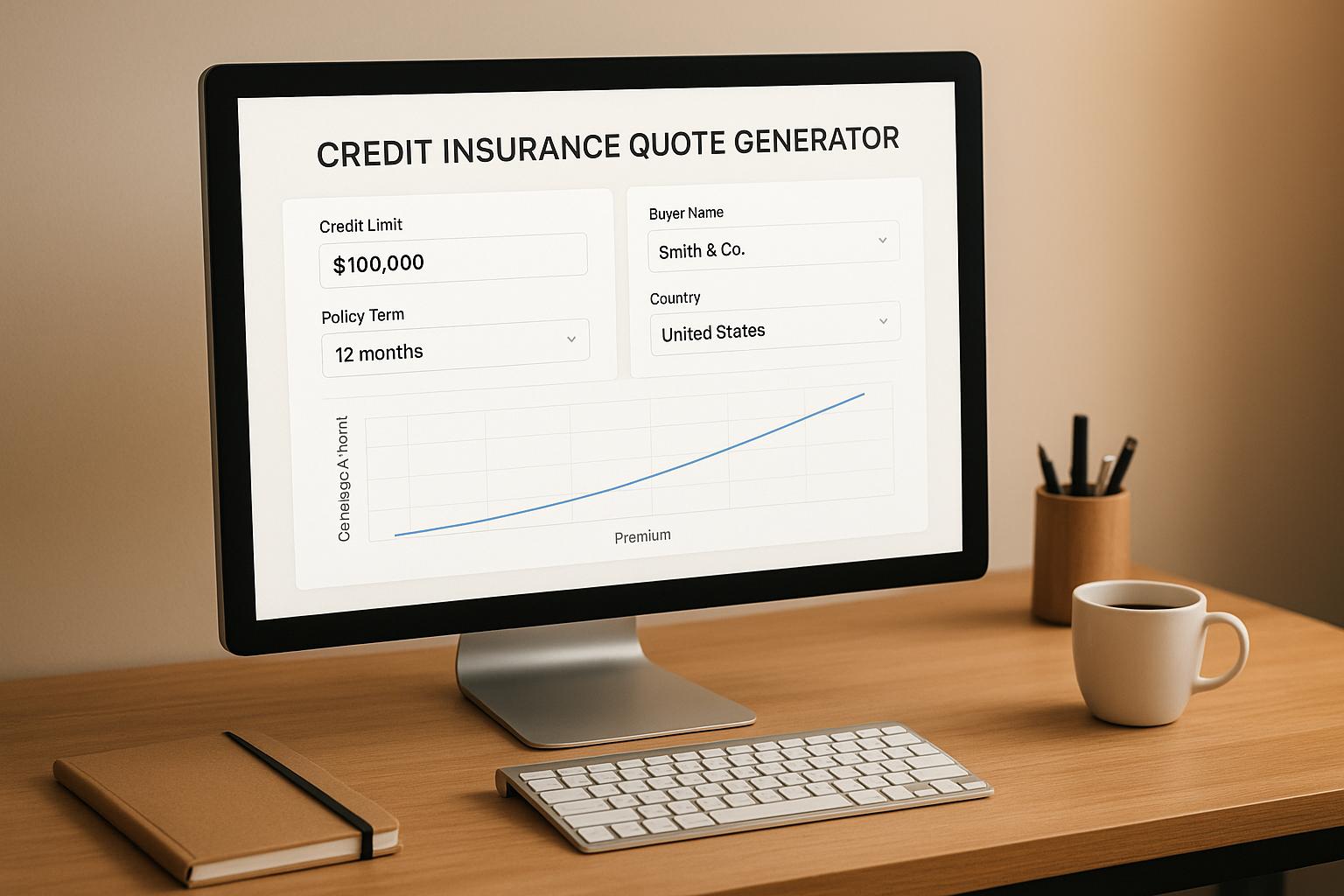Did you know that unpaid invoices can jeopardize a business’s financial health, especially when accounts receivable make up 40% of total assets? Domestic trade credit insurance helps U.S. businesses safeguard against such risks by covering up to 90% of unpaid invoices caused by customer insolvency or non-payment. Calculating insurance premiums accurately is key to balancing costs and coverage.
Key Takeaways:
- Premiums are typically 0.2% to 1% of insured sales, depending on factors like industry, customer credit risk, and sales volume.
- Two main payment methods: Single Premium (upfront payment) and Monthly Outstanding Balance (adjusts with sales fluctuations).
- Policies often include minimum premiums and year-end adjustments based on actual sales.
Understanding how premiums are calculated ensures businesses can protect their receivables, manage risks effectively, and maintain financial stability. Let’s dive into the details of premium calculations and how they support your business.
How much does Trade Credit Insurance (TCI) cost?
Main Methods for Calculating Premiums
In the United States, insurers use various methods to calculate trade credit premiums, tailoring them to fit different business models and risk profiles. Structuring premiums accurately is crucial for protecting your receivables and maintaining financial stability. Below, we’ll explore the main approaches insurers use to determine premium costs.
Percentage of Insured Sales Method
The percentage of insured sales method is the most commonly used approach for calculating trade credit insurance premiums in the U.S. It’s a straightforward way to determine your premium by applying a fixed percentage to your total insured sales or accounts receivable.
Typically, insurers charge between 0.05% and 0.6% of your annual turnover, with 0.2% being a frequent baseline rate. To calculate your annual premium, you multiply your total sales by the premium rate. For example, if your business generates $2 million in annual sales and your insurer applies a rate of 0.25%, your annual premium would be $5,000. Most insurers quote rates as a fraction of a percent, ensuring the method remains simple and predictable.
Single Premium vs. Monthly Outstanding Balance
While the percentage method establishes the baseline premium, insurers also offer different payment structures to align with a business’s cash flow. The two main options are the single premium and the monthly outstanding balance (MOB) methods.
- Single Premium Method: This option is ideal for businesses with steady, predictable annual sales. Here, you pay the entire premium upfront – usually at the start of the policy – based on your projected annual insured sales. This approach provides cost certainty and may even include discounts for early payment, simplifying budgeting.
- Monthly Outstanding Balance (MOB): The MOB method calculates premiums based on actual receivables, adjusting for sales fluctuations. Premiums are typically determined using the end-of-month or average daily balances. This method is particularly beneficial for businesses with seasonal sales or fluctuating receivables, as it scales naturally with changing sales volumes. However, late payments under this model could result in policy cancellations.
For businesses with revolving credit arrangements or varying credit terms for customers, the MOB method offers better flexibility. On the other hand, companies with stable sales cycles often find the single premium approach more straightforward.
Minimum Premiums and Annual Adjustments
Most trade credit insurance policies include minimum premium requirements and year-end adjustments to ensure fair pricing while accounting for actual business performance.
The minimum premium sets a baseline cost for coverage, regardless of your sales volume. During the application process, insurers estimate your annual turnover, which determines this baseline. Even if your actual sales fall below projections, you’ll still need to pay the minimum premium to maintain coverage.
At the end of the policy term, actual sales figures replace estimates. If your turnover exceeds projections, you may owe an additional premium. Conversely, lower-than-expected sales might result in a refund. These adjustments ensure pricing reflects your actual risk exposure. Factors like B2B turnover, operating regions, customer types, payment terms, and the desired coverage percentage all influence the final premium calculation, ensuring your policy aligns with the realities of your business throughout the year.
Factors That Affect Premium Rates
When it comes to calculating premium rates, several factors come into play. These factors build on the methods of premium calculation but ultimately reflect your overall risk profile. As Atradius USA explains, "Pricing is based on many different factors. The pricing calculation is based upon a small percentage of your annual sales and adjusted dependent upon these additional factors". In essence, your annual sales and risk exposure serve as the foundation for determining the final premium.
Sales Volume and Customer Credit Risk
Your annual sales turnover is the starting point for premium calculations, but the creditworthiness of your customers plays an equally critical role. Trade credit insurance providers evaluate the financial reliability of your customer base to determine the associated risk. If your customers have a strong track record of paying on time, your premiums are likely to be lower. On the other hand, high-risk customers can drive up costs. As PIB Insurance highlights, "if your customer base has a strong history of financial reliability, your premium is likely to be lower. Conversely, if your customers present a higher credit risk, you may face increased costs".
The diversity of your customer base also matters. Businesses that serve customers across multiple industries or countries may face higher premiums due to the perceived risk of bad debt. Insurers frequently review the credit risk of your customers, and these reviews can result in changes to credit limits and premium rates over the course of your policy. While customer-specific risks are a major factor, broader industry and market trends also come into play.
Industry Sector and Market Conditions
The industry you operate in can significantly influence your premium rates. Some industries carry more inherent risk than others, which insurers take into account when pricing policies. Additionally, economic conditions have a major impact. For example, business insolvencies are expected to surpass pre-pandemic levels in many countries by 2024, with a 40% increase reported for the 12 months ending March 31, 2024 [22, 23].
Sector-specific challenges also play a role. Andreas Tesch, Chief Market Officer at Atradius, explained, "At the beginning of last year, the trade credit industry faced one of the largest claims ever on one of the Brazilian retailers. We’ve seen a number of construction companies failing in 2023 and also retail in other countries due to structural changes…such as the move to ecommerce". These examples illustrate how shifts in specific sectors can influence insurance costs.
Market uncertainty adds another layer of complexity. Nicolas Garcia, Group Commercial Director at Coface, noted, "The level of uncertainty and the complexity has been at the highest level for at least the last decade. The tensions on the macro-economic and the political sides are huge". This heightened uncertainty often impacts how insurers assess risk and set premium rates.
Policy Customization and Risk Management Practices
The way your policy is structured can also affect the cost of your premiums. Factors such as coverage limits, deductibles, and retention levels give you flexibility to manage expenses. For example, opting for broader coverage will typically increase premiums, while choosing higher deductibles can help reduce them.
Your internal credit risk management practices can also make a difference. Insurers evaluate elements like your trading history, customer credit ratings, payment terms, and loss records when determining your risk profile. Businesses with strong credit management systems may benefit from lower premiums.
Geographic considerations further influence pricing. Countries with stable political environments and strong infrastructure generally result in lower insurance costs. For instance, exporting to countries like Canada or the United States is often less expensive to insure than exporting to developing nations [6, 19].
Finally, insurers take market outlook and future demand into account when setting rates, ensuring that premiums align with evolving risks and economic conditions.
sbb-itb-2d170b0
Premium Calculation Examples
Building on the methods outlined earlier, let’s explore how these calculations work in real-world scenarios.
Sample Calculation for Percentage of Insured Sales
One widely used method for determining trade credit insurance premiums is calculating a percentage of insured sales. For instance, imagine ABC Manufacturing has annual domestic sales of $5,000,000 and decides to insure 80% of its receivables. With a premium rate of 0.25%, the calculation would look like this:
- Insured sales amount: $5,000,000 × 0.80 = $4,000,000
- Annual premium: $4,000,000 × 0.0025 = $10,000
This method uses gross sales as the foundation for assessing risk exposure. Higher revenue often implies serving more customers, which increases exposure to potential losses. Insurers consider this when setting premiums, and credit profiles can further influence the final premium.
End-of-Year Adjustments Example
Year-end premium adjustments are common when actual sales differ from projections. If insured sales exceed the initial estimate, an additional premium is charged. Conversely, if sales fall short, a credit is issued. For example:
- If ABC Manufacturing’s insured sales increase from $4,000,000 to $4,500,000, the additional premium would be:
$500,000 × 0.0025 = $1,250 - If sales decrease to $3,500,000, the company would receive a credit of:
$500,000 × 0.0025 = $1,250
These adjustments ensure the premium aligns with actual exposure, maintaining fairness for both parties.
Comparison of Calculation Methods
Different calculation methods are better suited to specific business needs. The table below outlines three common approaches:
| Method | How It Works | Best For | Considerations |
|---|---|---|---|
| Single Premium | Premium is calculated upfront and added to the loan amount | One-time transactions, term loans | Increases monthly payments since the entire premium is paid upfront |
| Monthly Outstanding Balance | Premium is charged monthly based on the outstanding debt | Credit cards, revolving credit lines | Adjusts monthly as a separate charge |
| Percentage of Sales | Annual premium is based on a percentage of total insured sales | Ongoing trade relationships, predictable sales | May require year-end adjustments to reflect actual sales |
The single premium method involves a one-time upfront payment, while the monthly outstanding balance method adjusts dynamically with changes in receivables. Businesses with steady cash flow and predictable sales might lean toward percentage-based calculations, while those with seasonal variations could benefit from the flexibility of monthly adjustments.
Typically, credit insurance premiums for loans range from 1% to 5% of the monthly payment. In contrast, trade credit insurance rates are much lower, often between 0.1% and 0.5% of insured sales, depending on specific risk factors.
When choosing a calculation method, it’s essential to weigh your cash flow needs and sales patterns. A stable business model may benefit from percentage-based premiums, while a company with fluctuating sales might find a monthly outstanding balance approach more practical.
Summary and Key Points
Review of Premium Calculation Methods
When it comes to domestic trade credit insurance, premiums are calculated using three main approaches: applying a percentage to insured sales, choosing the right payment structure (like a single premium or monthly outstanding balance), and making annual adjustments based on sales. These premiums are determined as a percentage of a company’s turnover, combined with the assessed level of risk. Typically, the rates hover around a small fraction of one percent of a company’s sales.
Several factors shape these rates, including sales volume, the creditworthiness of customers, industry-specific risks, and overall market conditions. Additionally, the type of policy and the percentage of risk covered for each transaction play key roles in determining the final cost. Insurers evaluate various elements, such as trading history, customer credit ratings, credit terms, past losses, the industry sector, and the geographic location of customers, to assess risk and set the pricing structure.
For most businesses, premiums average about 0.25% of insured sales, making trade credit insurance a cost-effective way to mitigate non-payment risks. Whether a business opts for flat or adjustable premiums depends on its specific policy structure and operational needs. As shown in example calculations, structuring premiums correctly not only reflects the actual risk but also supports the financial health of the business. This approach directly connects to how Accounts Receivable Insurance (ARI) safeguards cash flow effectively.
How Accounts Receivable Insurance Supports Your Business
The structured premiums of ARI allow businesses to plan financially and manage risks with clarity. By understanding how premiums are calculated, companies can better control costs and see trade credit insurance as a valuable investment. This coverage offers protection against the non-payment of commercial debts and secures business-to-business accounts receivable.
With ARI, businesses can protect their capital, maintain steady cash flow, and safeguard earnings – all while extending competitive credit terms to their customers. This protection enables companies to confidently grow their sales, secure better financing terms, and make smarter decisions using the risk data provided by insurers. In fact, banks often acknowledge the value of ARI by offering loans of up to 85% on insured receivables.
"Trade credit insurance, at its core, protects a seller’s cash flow, earnings and potentially years of accumulated retained earnings from the impact of buyer nonpayment." – Securitas Global
Beyond financial protection, ARI provides businesses with access to detailed insights about customer creditworthiness, allowing them to prevent losses and make well-informed credit decisions. This intelligence is especially critical given that accounts receivable often make up around 40% of a company’s assets. By reducing exposure to risks, ARI empowers businesses to seize growth opportunities, extend credit to larger customers, and offer more attractive payment terms.
FAQs
What’s the difference between the Single Premium and Monthly Outstanding Balance methods for trade credit insurance, and how do I choose the right one?
The decision between Single Premium and Monthly Outstanding Balance methods really comes down to what works best for your business’s financial situation and cash flow priorities.
If you’re looking for a straightforward option with predictable expenses, the single premium method could be a good fit. With this approach, you pay the entire premium upfront at the beginning of the policy. This makes it easier to plan your budget since you’ll know exactly what the coverage will cost for the entire term.
Alternatively, the monthly outstanding balance method might be more appealing if you want your premiums to reflect your actual credit exposure. Instead of one lump sum, payments are spread out over time and adjust based on your outstanding balances. This can provide added flexibility and help you manage cash flow more effectively.
What should I consider when assessing customer credit risk to calculate trade credit insurance premiums?
When determining customer credit risk for premium calculations, it’s essential to zero in on a few critical elements. Start by evaluating the creditworthiness of your buyers and their overall financial health, including factors like cash flow and debt levels. Don’t overlook the broader picture either – things like the economic and political stability of the buyer’s country can play a big role in shaping risk.
You should also take into account industry trends and market conditions, as well as potential currency fluctuations that could influence the outcome of transactions. On a more granular level, assess transaction-specific risks such as the size of the order and the agreed payment terms. By diving deep into these aspects, you can better gauge the chances of non-payment and set premiums that align with the actual risk.
What are year-end adjustments in trade credit insurance premiums, and how can they affect your business?
Year-End Adjustments in Trade Credit Insurance Premiums
Year-end adjustments in trade credit insurance premiums happen when your insurer revisits your actual sales or credit activity during the policy period to ensure the premium aligns with your business’s performance. If your activity exceeded the initial estimates, you might face additional charges. On the other hand, if your activity was lower than expected, you could receive a refund.
These adjustments can directly affect your cash flow and budgeting. Higher premiums mean added costs, while refunds can provide a financial boost. To avoid surprises, it’s a good idea to keep a close eye on your credit activity throughout the year and maintain detailed records. This way, you’ll have the right coverage without paying more than necessary.



